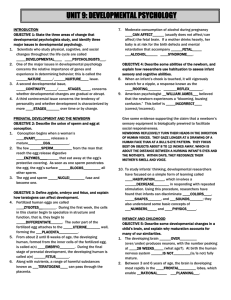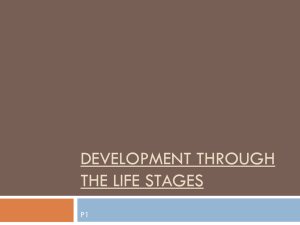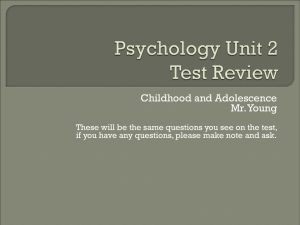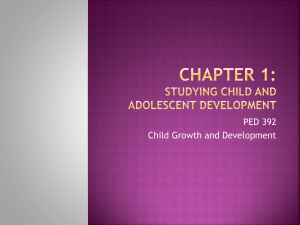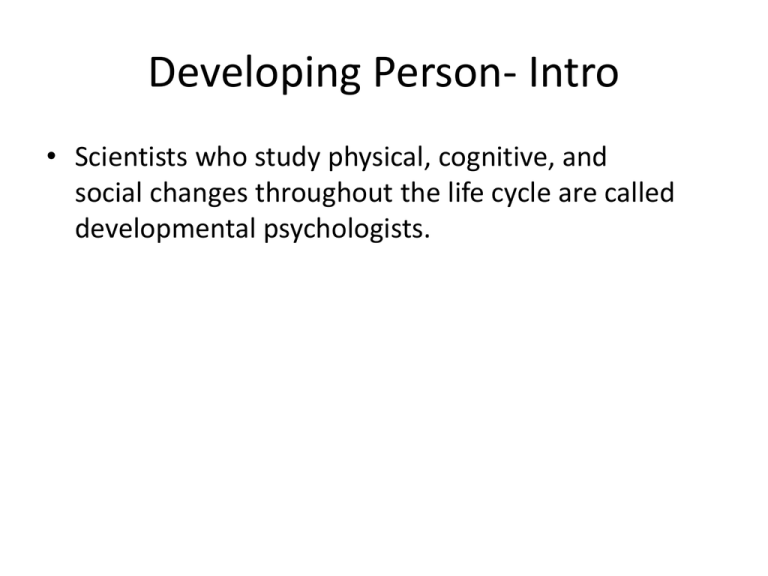
Developing Person- Intro
• Scientists who study physical, cognitive, and
social changes throughout the life cycle are called
developmental psychologists.
Developmental Psychology- work on
Major Issues
Issue
Nature/Nurture
Continuity/Stages
Stability/Change
Details
How do genetic inheritance
(our nature) and experience
(the nurture we receive)
influence our behavior?
Is developmental a gradual,
continuous process or a
sequence of separate stages?
Do our early personality
traits persist through life, or
do we become different
persons as we age.
2
Prenatal Development and the
Newborn
• Conception begins when a
woman’s ovary releases a mature
egg
• The few sperm that reach the
egg, release digestive enzymes
that eat away the egg’s protective
covering. As soon as one sperm
penetrates the egg, the egg’s
surface blocks all other sperm.
• The egg and sperm nuclei fuse
and become one.
• Fertilized eggs are called zygotes.
• Week one- cells begin to
differentiate while the outer part
of the fertilized egg attach to the
uterine wall.
Prenatal Development and the
Newborn
• From 2 weeks until 8 weeks,
the developing human is
formed from the inner cells of
the fertilized egg, is called a
embryo. During the final stage
of prenatal development, the
developing human is called a
fetus.
• Formed as the zygote attached
to the uterus, the placenta
transfers nutrients and oxygen
from the mother to the fetus.
Along with nutrients, a range
of harmful substances known
as teratogens can pass through
the placenta
Prenatal Development and the
Newborn
• Moderate consumption of alcohol
can affect the fetal brain. If a
mother drinks heavily, her baby is
at risk for birth defects and
mental retardation that
accompany fetal alcohol
syndrome.
• When a infant’s cheek is
touched, it will vigorously root for
a nipple. Other instant reflexes
include sucking, swallowing,
tonguing, and breathing.
• William James believed that a
newborn experiences a
“blooming, buzzing confusion.”
This belief is incorrect.
Prenatal Development and the
Newborn
• To study a infants’ thinking
– psychologists have used a
simple form of learning
called habituation, which
involves a decrease with
repeated stimulation . Using
the novelty- preference
procedure, researchers
have found that infants
prefer sights, such as faces,
that facilitate social
responsiveness
Infancy and Childhood
• The developing brain over
produces neurons. At birth,
the human nervous system is
not fully mature.
• Between 3-6, brain is
developing most rapidly in the
frontal lobes which enable
rational planning. The last
areas to develop are the
association areas which are
linked with thinking memory
and language.
• After puberty, a process of
pruning shuts down neural
connections and strengthens
others.
Infancy and Childhood
• Biological growth
processes that enable
orderly changes in
behavior are called
maturation.
• Infants pass the
milestones of motor
development at different
rates, but the basic
sequence of stages is
fixed. Infants sit before
they crawl and walk
before they run.
Infancy and Childhood
• Genes play a major role in
motor development.
• Until the necessary muscular
and neural maturation is
complete, including the rapid
development of the brain’s
cerebellum, experience has a
small effect on learning to
walk for example.
• Our earliest memories
generally do not occur before
age 3. This phenomenon is
known as infantile amnesia.
Piaget stages of Cognitive
Development
• Cognition refers to all of
the mental activities
associated with thinking,
knowing, remembering,
and communicating.
• First researcher to realize
thought processes were
different was Jean Piaget.
• To organize and interpret
his or her experiences,
the developing child
constructs cognitive
concepts called schemas.
Piaget stages of Cognitive
Development
• The interpretation of
new experiences in
terms of existing ideas
is called assimilation.
The adaption of existing
ideas to fit new
experiences is called
accommodation.
• Picture of Piaget- could
not find good picture
Piaget’s Theory and Current Thinking
12
Piaget
In the sensorimotor stage
(0-2), babies take in the
world by looking, hearing,
touching, mouthing, and
grasping. Children
younger than 6 months of
age do not grasp object
permanence, i.e., objects
that are out of sight are
also out of mind (at 8
months they do)
Piaget
•
•
•
Developmental researchers have
found that Piaget and his followers
underestimated young children’s
competence. They underestimated
babies grasp of simple laws of physics
and a understanding of mathematics
According to Piaget, during the
preschool years and up to age 6 or 7,
children are in the preoperational
stage.
The principle that the quantity of a
substance remains the same when
the shape of the container changes is
called conservation. Piaget believed
preschoolers have not developed this
concept. (at 6 they can’t, at 8 they
can)
Piaget
• Preschoolers have difficulty
perceiving things from
another person’s point of
view. This inability is called
egocentrism. The child’s
growing ability to take
another person’s
perspective is evidence that
the child is acquiring a
theory of mind. Between 3
and a half and 4 and a half,
children come to realize
that others hold false
beliefs.
Piaget
•
This disorder characterized by
deficient communication and social
interaction and an impaired theory of
mind is autism. This disorder is
related to malfunctions of brains
areas that allow us to take another’s
viewpoint. The “high functioning”
form of this disorder is called
Asperger Syndrome.
•
Baron- Cohen’s theory proposes that
autism represents an “extreme male
brain.” According to this theory, girls
tend to be empathizers, who are
better than boys at reading facial
expressions and gestures. Boys tend
to be systemizers, who understand
things in terms of rules or laws.
Piaget
• In contrast to Piaget’s findings,
researchers have discovered
that the abilities to perform
mental operations, to think
symbolically, and to take
another’s perspective begin to
show up early and continue to
develop gradually.
• Russian psychologist Lev
Vygotsky noted that by age 7
children stop thinking aloud
and instead rely on inner
speech. Talking to themselves
helps children control their
behavior and actions. Picture
of Vygotsky
Piaget
• Piaget believed that children
acquire the mental abilities
needed to be comprehend
mathematical transformations
and conservation by about 6
or 7 years of age. At this stage,
they enter the concrete
operational stage.
• In Piaget’s final stage, the
formal operational stage,
reasoning expands from the
purely concrete to encompass
abstract thinking. Piaget
believed most children begin
to enter this stage by age 12.
Piaget
• Completing Piaget’s
emphasis on interaction
with the physical
environment is Vygotsky’s
emphasis on interaction
with the social
environment. When parents
mentor children and give
them new words., they
provide, according to
Vygotsky, a scaffold upon
which the child can build
higher level thinking.
Nourishment, Body Contact, and
Familiarity on Infant Social Attachment
• Soon after object permanence
emerges and children become
mobile, a new fear, called
stranger anxiety emerges.
• The fear emerges at about age 8
months.
• The development of a strong
emotional bond between infants
and parents is called attachment.
• Harlow’s studies of monkeys have
shown that mother- infant
attachment does not depend on
the mother providing the comfort
of body contact. Another key to
attachment is familiarity
Nourishment, Body Contact, and
Familiarity on Infant Social Attachment
•
•
•
Human attachment involves one
person providing another with a safe
haven when distressed and a secure
base from which to explore.
In some animals, attachment will
occur only during a restricted time
called a critical period. Lorenz
discovered that young birds would
follow almost any object if it were the
first moving thing they observed. This
phenemenon is called imprinting.
Human infants do not have a precise
critical period for becoming attached.
However, because of mere exposure ,
they attach to what they know
Secure and Insecure Attachment- Role
of Parents
• Placed in a research setting
called the strange situation,
children show one of two
patterns of attachment:
Secure attachment or Insecure
attachment. A father’s love
and acceptance for his
children are comparable to a
mother’s love in predicating
their children’s health and
well- being.
• Separation Anxiety peaks in
infants around 13 months,
then gradually declines. This is
true of children throughout
the world.
Secure and Insecure Attachment- Role
of Parents
• According to Erikson,
securely attached infants
approach life with a sense
of basic trust.
• Most researchers now
believe that the early
attachments do form the
basis of adult
attachments. Attachment
style is also associated
with motivation. Securely
attached people exhibit
greater drive to achieve.
Parent Neglect, Family Disruption, and
Day Care
• The Harlows found that when
monkeys reared in social
isolation were placed with
other monkeys, they reacted
with either fear or aggression.
• Most abused children do not
later become abusive parents.
• Although most children who
grow up under adversity are
resilient and become normal
adults, early abuse and
excessive exposure to stress
hormones may alter the
development of the brain
chemical serotonin.
Parent Neglect, Family Disruption, and
Day Care
• When placed in a more positive
and stable environment, most
infants recover from disruptions
of attachment.
• Experts agree that child care per
se does not constitute a risk
factor in children’s development.
• High quality care- supportive
interactions with adults that is
safe, healthy, and stimulating.
More important than time spent
in day care in influencing a child’s
development are the family’s
economic and educational levels.
Children’s Self Concept
• Primary social achievement
of childhood is the
development of a self
concept which occurs in
most children by age 12.
• A child’s self image
generally becomes stable
between the ages of 8 and
10, when children begin to
describe themselves in
terms of gender, group
memberships, and
psychological traits.
Describe Three Parenting Styles- Know
what is most effective?
• Parents who impose rules and
expect obedience are exhibiting a
authoritarian style of parenting
• Parents who make few demands
of their children and submit to
their desires are known as
permissive.
• Setting and enforcing standards
after discussion with their
children is the approach taken by
authoritative parents
• Studies have shown that children
with the highest self- esteem,
self- reliance, and social
competence usually have
authoritative parents
Adolescence
• Adolescence is defined at the
transition period between
childhood and adulthood.
• The storm and stress view of
adolescence is credited to G.
Stanley Hall, a psychologist
who studies adolescence.
• Begins at puberty- typically 11
for girls and 13 for boys.
Growth is marked by primary
sex characteristics (genitalia,
reproductive organs as well as
secondary sex characteristics
pubic hair, breasts, etc)
Adolescence
• First menstrual period
called menarche. In boys,
the first ejaculation is called
spermarche
• The sequence of pubertal
changes is more predictable
than their timing.
• Boys Maturing Early
Characteristics- popular,
self- assured, independent,
prone to alcohol use,
delinquency, premature
sexual activity
Adolescence
• Girls Maturing Earlystressful because their
bodies are out of sync with
their emotional maturity.
Reminds us that heredity
and environment interact.
• Adolescent brain begins to
go through pruning where
unused neurons and
connections are let go.
Impulsiveness and riskiness
comes from the fact that
the frontal lobe lags behind
the limbic system
Adolescents’ Reasoning and Moral
Abilities
• Adolescents’ developing
cognitive ability enables them
to think about what is ideally
possible and compare that
with imperfect reality.
• During early teen years,
reasoning is often selffocused, as adolescents often
feel their experiences as
unique.
• Piaget- final stage- concrete
operational- characterized by
abstract thought which
enables them to spot
inconsistencies and hypocrisy
Adolescents’ Reasoning and Moral
Abilities
• The theorist who proposed that
moral thought progresses
through stages is Lawrence
Kohlberg. These stages are
divided into preconventional,
conventional, postconventional
• Preconvention- obey rules in
order to avoid punishment or
gain rewards
• Convential- emerges in early
adulthood; Emphasis is gaining
social approval or upholding
social order
• Postconvential- - individuals who
base moral judgments on their
own perceptions of basic ethical
principles
Adolescents’ Reasoning and Moral
Abilities
•
•
•
•
The idea that moral feelings precede
moral reasoning is expressed in the
social intuitionist explanation of
morality. Research studies using
moral paradoxes involves more than
merely thinking; it is also a gut- level
feeling.
Morality depends on social influence.
Today’s character education
programs have the goals of teaching
children empathy for other’s feelings.
Children who learn to delay
gratification- more socially
responsible through service learning.
Tend to have better academic
success.
Moral ideas grow stronger when
acted on
Erikson’s 8 Stages
Erikson’s 8 Stages
• To refine their sense of
identity, adolescents in
individualistic cultures
experiment with different
selves in different situations.
The result may be role
confusion, which is resolved by
forming a self- definition, or
identity.
• Some adolescents forge their
identity early, simply by
adopting their parents values
and expectations. Others may
assume an identity opposing
that of their parent
Erikson’s 8 Stages
• During early to mid- teen
years, self- esteem
generally falls. During the
late teens and twenties,
self- esteem generally
rises and identity
becomes more
personalized.
• Erikson saw the formation
of identity a prerequisite
for the development of
intimacy in young
adulthood.
Parental and Peer Influences
•
•
•
•
•
Adolescence is typically a time of
increasing influence from one’s peers
and decreasing influence from
parents.
Most adolescents report they do get
along with parents who tend to
shape religious faith.
When rejected adolescents withdraw,
they are vulnerable to loneliness,
self- esteem, and depression.
As a result of increased body fat and
weakened parent- child bonds, sexual
maturity is beginning earlier than in
the past.
Emerging Adulthood- time from 18 to
mid 20’s characterized by a not so
settled phase of life
Adulthood
• During adulthood, age is not
a very good predictor of
people’s traits.
• Mid Twenties characterized
by increased muscular
strength, reaction time,
sensory keenness, cardiac
output. Because they
mature earlier, woman also
peak earlier.
• During mid 20’s, physical
vigor has less to do with age
than a person’s health and
exercise habits.
Adulthood
• The cessation of the
menstrual cycle known as
menopause, occurs within a
few years of 50. Lower
levels of estrogen are
produced. Woman’s
experience during this time
depends largely on her
expectations and attitudes.
• Men experience lower
sperm counts and lower
levels of testosterone, and
speed of erection and
ejaculation during later life
Adulthood
• Life expectancy increased from 49
years in 1950 to 80 years and
beyond in developing countries.
Woman outlive men by 4 years
worldwide, 5 in Canada, US, and
Australia. With age, the tips of
our chromosomes, called
telomeres, shorten.
• Evolutionary theory suggests our
bodies age and wear out because
once we have completed our
gene- producing and nurturing
task, there are no natural
selection pressures against genes
that cause degeneration in later
life.
Adulthood
• Human Spirit matters.
Amazingly, people tend to pass
right after their birthdays, a
finding referred to as the
death- deferral phenomenon.
• With age, the eye’s pupil
shrinks and lens become less
transparent. As a result, the
amount of light that reaches
the retina is reduced.
• Although older adults are
more susceptible to lifethreatening ailments, they
suffer from short- term
ailments such as flu less than
young adults.
Adulthood
• Aging slows neural processing
and causes a gradual loss of brain
cells.
• Exercise stimulates brain cell
development and neural
connections, thanks perhaps to
increased oxygen and nutrient
flow.
• The mental erosion that results
from progressive damage to the
brain is called dementia.
• Alzheimer's Disease- irreversible
disorder that causes progressive
brain deterioration. Linked to a
deterioration of neurons that
produce AcH. (acetylcholine)
Aging on Memory and Intelligence
• Studies on learning and
memory show that during
adulthood there is a decline in
the ability to recall new info.,
but not in the ability to recall
such info. One factor that
influences memory in the
elderly is the meaningfulness
of the material
• Adults prospective memory
remains strong when events
help trigger recall.
• Cognitive abilities among 70
year olds are more varied than
20 year olds
Aging on Memory and Intelligence
• Longitudinal Studiescompare people at various
ages. Found evidence of
intellectual decline during
adulthood.
• Crystallized Intelligenceaccumulation of stored info
that comes from education
and experience which tends
to increase with age
• The ability to reason
abstractly is referred to as
fluid intelligence, which
tends to decline with age
Path of Adult Development
•
•
•
Contrary to public opinion, job and
marital dissatisfaction do not surge
during the 40’s, thus suggesting that
a midlife crisis need not occur.
The term used to refer to the
culturally preferred timing for leaving
home, getting a job, marrying, sand
so is the social clock. Timing of these
events is less predictable. More
important than age are life events
and chance encounters
According to Erikson, the two basic
tasks of adulthood are achieving
intimacy and generativity. According
to Freud, the healthy adult is one
who love and work.
Path of Adult Development
• Human societies have nearly
always included a relatively
monogamous bond. Marriage
bonds are usually lasting when
couples marry after age 20 and
are well educated.
• Today’s marriage- twice as likely
to end in divorce than in 1960.
Couples that live together prior to
marriage have a higher rate of
divorce.
• Marriage is a predictorhappiness, sexual satisfaction,
health, income. Lesbian couples
report a greater well being than
those who are alone.
Path of Adult Development
• As children begin to absorb
time and energy, satisfaction
with the marriage itself
decreases. This is particularly
true among employed women,
who shoulder most of the
burden.
• For most couples, the
children’s leaving home
produces an increase in
marital satisfaction.
• During first two years of
college, most students cannot
predict their later careers.
Most do shift from their
original major.
Life Satisfaction
• From early adulthood to
midlife, people typically
experience a strengthening
sense of identity, confidence,
and self- esteem.
• According to studies, older
people do report as much
happiness and satisfaction
with life as younger people do
and their feelings do mellow.
• As we age, the brain areas
called the amygdale show
decreased activity in response
to negative events. People do
better later in life due to
biopsychosocial influences.
Life Satisfaction
• Grief over a loved one’s death
is especially severe when it
comes suddenly.
• Reactions to a loved one’s
death do vary according to
cultural norms. Those who
show greatest grief do not
purge their grief more quickly.
• Terminally ill and bereaved
people do not go through
predictable stages
• According to Erickson, the final
task of adulthood is to achieve
a sense of integrity.
Successful Aging
Developmental Issues
• Continuity and Stages
• Researchers who view
development as a slow,
continuous process are
generally those who
emphasize experience and
learning. Biologists, on the
other hand, view maturation
and development as a series
of genetically predisposed
steps or stages. These include
psychologists like Piaget,
Kohlberg and Erikson.
Developmental Issues
• Stability and ChangeLifelong development
requires both stability
and change. Personality
gradually stabilizes as
people age. However,
this does not mean that
our traits do not change
over a lifetime. Some
temperaments are more
stable than others




